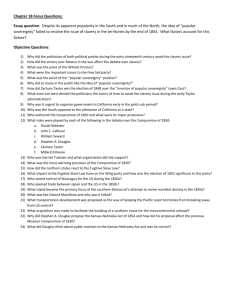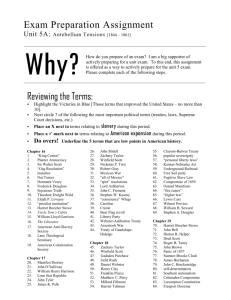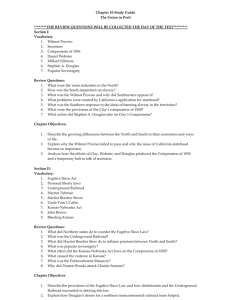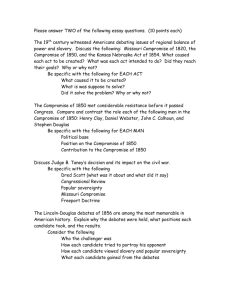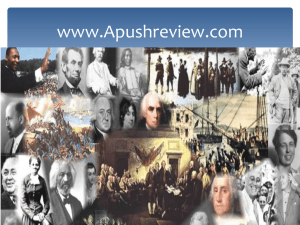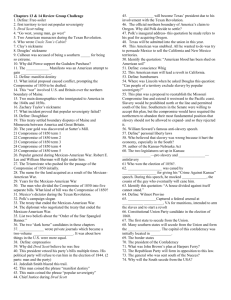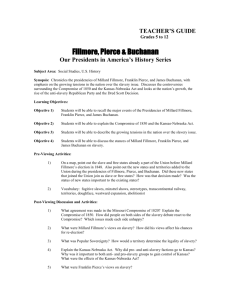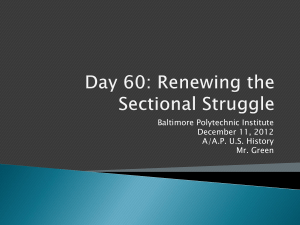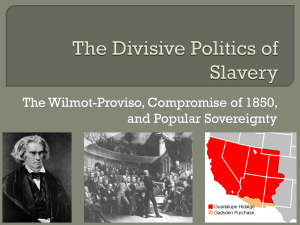Renewing the Sectional Struggle: 1848-1854
advertisement
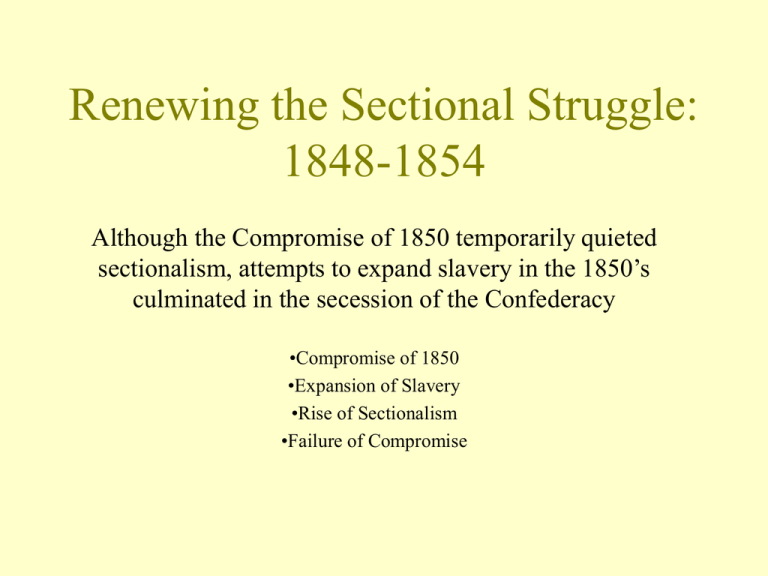
Renewing the Sectional Struggle: 1848-1854 Although the Compromise of 1850 temporarily quieted sectionalism, attempts to expand slavery in the 1850’s culminated in the secession of the Confederacy •Compromise of 1850 •Expansion of Slavery •Rise of Sectionalism •Failure of Compromise I. Compromise of 1850 A. Background Events 1. 2. Wilmot Proviso, 1848 The compromise: Popular Sovereignty Election 1848 3. a. b. 4. B. Taylor/Fillmore (W) v. Cass (D) “Free soil, free speech, free labor, free men.” CA Gold Rush Background Issues 1. 2. 3. Political balance of slavery CA and Mexican Cessation? Fugitive Slave Law, 1793 a. Harriet Tubman 4. 5. C. Disputed territory with TX Slavery in D.C. (1000 per year) Negotiations A. B. C. D. Clay and Douglas and Webster and Fillmore Calhoun William “higher law” Seward Provisions (PopFACT) Manifest Destiny SF Walking Tour, Dec. 21st II. Expansion of Slavery A. Election of 1852 1. 2. Pierce a proslave northerner supported the F.S.L. (D) Scott’s (W) support of F.S.L. alienated southern Whigs B. International Expansion 1. Asia a. b. 2. Treaty of Wanghia, 1844 Commodore Perry, 1852 Latin America a. b. c. Clayton-Bulwer Treaty, 1848 W. Walker in Nicaragua Ostend Manifesto, 1854 II. Expansion of Slavery (cont.) C. Domestic Expansion: Transcontinental RR 1. 2. Gadsden Purchase Proposed territory of NB and KS a. b. 3. S. Douglas Popular Sovereignty Reactions! a. b. c. d. North “Free-Soilers” Southern “Fire-eaters” Crash of Democratic Party-28 years Creation of GOP Chapter 18 Vocabulary • • • • • • • • • • • • • • Lewis Cass Stephen Douglas Franklin Pierce Zachary Taylor John Calhoun Winfield Scott Martin Van Buren Daniel Webster Matthew Perry Harriet Tubman William Seward James Gadsden Henry Clay Millard Fillmore • • • • • • • • • • • • • Popular Sovereignty Filibustering Free Soil Party Fugitive Slave Law “conscience Whigs” “personal liberty laws” Underground Railroad Compromise of 1850 “fire-eaters” Clayton-Bulwer Treaty Ostend manifesto “higher law” Kansas-Nebraska Act III. Rise of Sectionalism A. Voices of Sectionalism 1. 2. B. Harriet Beecher Stowe Hinton Helper Case Study: “Bleeding KS” 1. Emigration into KS a. 2. Territorial vote, 1855 a. b. 3. John Steuart Curry’s Tragic Prelude (1938-1940) Attack on Lawrence, KS Pottawatomie Massacre, 1856 Caning of Senator Sumter Election of 1856 1. 2. 5. “border ruffians” Free-soilers in Topeka Violence a. b. c. 4. NEEAC and “Beecher’s Bibles” Buchanan (D) v. Fremont (R) v. Fillmore (“Do Not”) No extension of slavery (R) v. Popular Sovereignty (D) Statehood vote, 1857 a. b. Pro-slavery LeCompton Constitution Buchanan upsets N. Demos and Douglas upsets S. Demos. IV. Failure of Compromise A. Dred Scot Decision 1. 2. 3. 4. 5. B. Financial Crisis of 1857 1. 2. 3. C. Ca Gold and Over-production/speculation Western demand for free land Industrialists demand for higher tariffs Lincoln-Douglas Debates, 1858 1. 2. D. Pro-Slave majority on court (Taney) Hit #1: No citizenship for blacks Hit #2: Slaves be taken anywhere (5th) Hit #3: Missouri Compromise unconstitutional (5th) North horrified, “It’s an opinion, not decision!” GOP spotlight Freeport Doctrine-territories could refuse to pass laws protecting slavery—ending slavery. Harper’s Ferry, 1859 1. 2. Establish free black state Became a martyr in north and feared in the south Standing Lincoln, Lincoln Park, Chicago IV. Failure of Compromise (cont.) E. Election of 1860 1. Democrats a. Douglas b. Breckinridge 2. Constitutional Union 1. Bell 3. Republicans 1. Lincoln F. Tragic Chain Events 1. 2. 3. 11 states secede by VA Confederate States of Am., 1861 Crittenden amendments Chapter 19 Vocabulary • • • • • • • • • • • Harriet Beecher Stowe Hinton Helper John Brown James Buchanan Charles Sumner John C. Fremont Dred Scott Roger Taney John Breckenridge John Bell Jefferson Davis • Uncle Tom’s Cab • New England Immigrant Aid Company • Pottawatowie • Lecompton Constitution • “Bleeding Kansas” • American Party • Dred Scot • Panic of 1837 • Freeport Doctrine • Constitutional Union party • Crittenden Comprise
